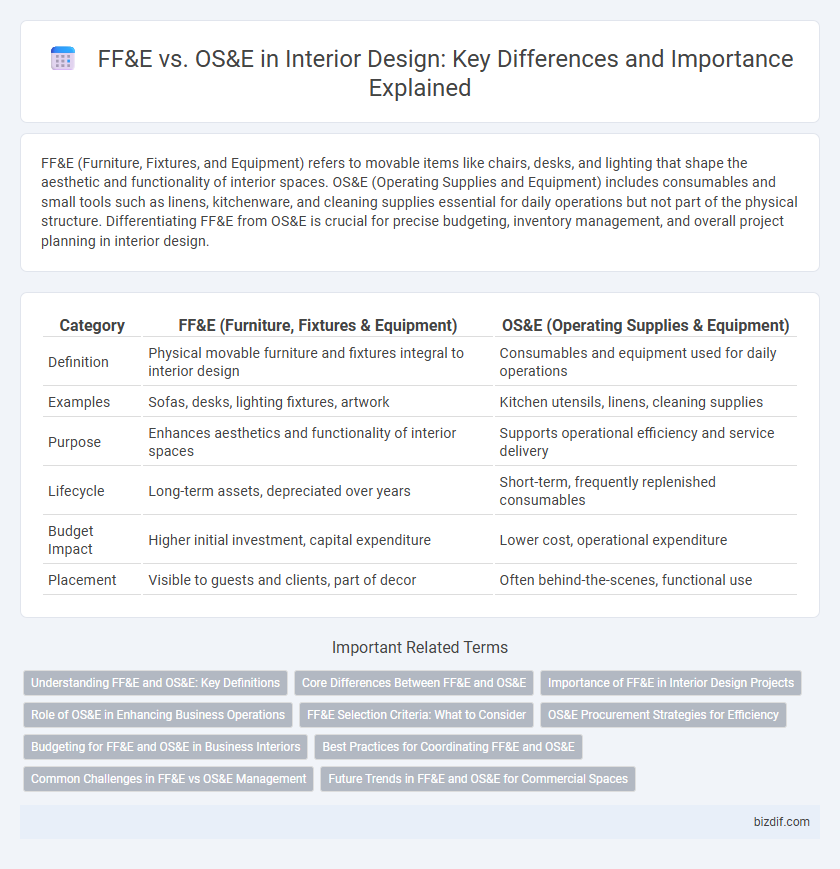FF&E (Furniture, Fixtures, and Equipment) refers to movable items like chairs, desks, and lighting that shape the aesthetic and functionality of interior spaces. OS&E (Operating Supplies and Equipment) includes consumables and small tools such as linens, kitchenware, and cleaning supplies essential for daily operations but not part of the physical structure. Differentiating FF&E from OS&E is crucial for precise budgeting, inventory management, and overall project planning in interior design.
Table of Comparison
| Category | FF&E (Furniture, Fixtures & Equipment) | OS&E (Operating Supplies & Equipment) |
|---|---|---|
| Definition | Physical movable furniture and fixtures integral to interior design | Consumables and equipment used for daily operations |
| Examples | Sofas, desks, lighting fixtures, artwork | Kitchen utensils, linens, cleaning supplies |
| Purpose | Enhances aesthetics and functionality of interior spaces | Supports operational efficiency and service delivery |
| Lifecycle | Long-term assets, depreciated over years | Short-term, frequently replenished consumables |
| Budget Impact | Higher initial investment, capital expenditure | Lower cost, operational expenditure |
| Placement | Visible to guests and clients, part of decor | Often behind-the-scenes, functional use |
Understanding FF&E and OS&E: Key Definitions
FF&E (Furniture, Fixtures, and Equipment) includes movable items such as chairs, desks, lighting, and decorative elements essential for interior design setups. OS&E (Operating Supplies and Equipment) refers to consumable goods and non-fixed equipment like linens, kitchenware, and cleaning supplies that support daily operations. Differentiating FF&E from OS&E is crucial for precise budgeting, procurement, and project management in commercial interior design projects.
Core Differences Between FF&E and OS&E
FF&E (Furniture, Fixtures, and Equipment) refers to movable items such as chairs, desks, and lighting that are essential for the interior design of a space but are not permanently attached. OS&E (Operating Supplies and Equipment) encompasses consumable and non-fixed items like linens, kitchen utensils, and cleaning supplies critical for daily operations. The core difference lies in FF&E's role in establishing the structural aesthetics, while OS&E focuses on the functional and operational needs within the designed environment.
Importance of FF&E in Interior Design Projects
FF&E (Furniture, Fixtures, and Equipment) plays a critical role in interior design projects by defining the aesthetic appeal and functional layout of commercial and residential spaces. These elements contribute to the overall ambiance, comfort, and usability, directly impacting client satisfaction and space efficiency. Unlike OS&E (Operating Supplies and Equipment), which focuses on consumable and operational items, FF&E investments have a lasting influence on the visual identity and long-term value of interior environments.
Role of OS&E in Enhancing Business Operations
OS&E (Operating Supplies and Equipment) plays a critical role in enhancing business operations by providing essential items that support daily functionality in hospitality and commercial interiors, such as linens, kitchenware, and cleaning supplies. Unlike FF&E (Furniture, Fixtures, and Equipment), which focuses on long-term assets and aesthetic elements, OS&E ensures operational efficiency and guest satisfaction through practical, consumable goods. Integrating quality OS&E items optimizes workflows, reduces downtime, and contributes to a seamless customer experience, directly impacting a business's overall performance.
FF&E Selection Criteria: What to Consider
FF&E selection criteria prioritize durability, style, and functionality to align with the overall interior design theme and client needs. Materials must withstand daily wear while complementing spatial aesthetics, emphasizing ergonomic comfort and ease of maintenance. Budget constraints and supplier reliability also play critical roles in ensuring high-quality, cost-effective choices that enhance long-term value.
OS&E Procurement Strategies for Efficiency
OS&E procurement strategies prioritize vendor consolidation and bulk purchasing to reduce costs and streamline delivery schedules. Implementing technology-driven inventory management systems enhances tracking accuracy and accelerates order fulfillment. Leveraging long-term supplier relationships supports consistent quality and minimizes supply chain disruptions in interior design projects.
Budgeting for FF&E and OS&E in Business Interiors
Budgeting for FF&E (Furniture, Fixtures & Equipment) and OS&E (Operating Supplies & Equipment) requires distinct approaches in business interiors due to their differing cost characteristics and lifecycle. FF&E involves significant capital expenditure with long-term depreciation, often necessitating detailed cost forecasting and allocation for furniture, lighting, and built-ins. OS&E includes recurring expenses for consumables like linens, kitchenware, and small equipment, demanding precise operational budgeting to ensure consistent supply without overspending.
Best Practices for Coordinating FF&E and OS&E
Effective coordination of FF&E (Furniture, Fixtures, and Equipment) and OS&E (Operating Supplies and Equipment) is essential for seamless interior design project execution, ensuring operational efficiency and aesthetic coherence. Best practices include early integration of FF&E and OS&E planning in the design phase, maintaining detailed inventory management systems, and fostering close collaboration between design, procurement, and operations teams to align specifications and delivery timelines. Leveraging digital tools like BIM (Building Information Modeling) enhances real-time tracking and coordination, minimizing delays and cost overruns while achieving a unified interior environment.
Common Challenges in FF&E vs OS&E Management
Managing FF&E (Furniture, Fixtures & Equipment) and OS&E (Operating Supplies & Equipment) presents challenges such as coordinating delivery timelines, ensuring quality compliance, and controlling costs. FF&E requires careful selection of durable, aesthetic items that align with interior design themes, while OS&E focuses on operational essentials that support day-to-day functionality. Balancing procurement schedules and vendor management for both categories demands strategic planning to avoid project delays and budget overruns.
Future Trends in FF&E and OS&E for Commercial Spaces
Future trends in FF&E (Furniture, Fixtures, and Equipment) and OS&E (Operating Supplies and Equipment) for commercial spaces emphasize sustainability, smart technology integration, and modular design. Eco-friendly materials and energy-efficient fixtures dominate new commercial projects, while IoT-enabled devices and adaptable furnishings enhance functionality and user experience. The convergence of these innovations supports flexible, resilient environments that meet evolving business and occupant needs.
FF&E vs OS&E Infographic

 bizdif.com
bizdif.com